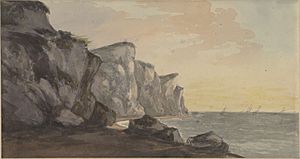William Sawrey Gilpin facts for kids
William Sawrey Gilpin (born October 4, 1762 – died April 4, 1843) was a talented English artist and a teacher of drawing. Later in his life, he became famous for designing beautiful gardens and parks.
Contents
Who Was William Sawrey Gilpin?
William Sawrey Gilpin was born in a place called Scaleby Castle in Cumbria, England. His father, Sawrey Gilpin, was also a painter, especially known for painting animals.
William went to school at Cheam in Surrey. His uncle, William Gilpin, ran the school. This uncle was very important because he came up with the idea of the "Picturesque" in art and landscape design.
William Sawrey Gilpin married Elizabeth Paddock. They had at least two sons. He passed away at Sedbury Hall in North Yorkshire and was buried nearby in the churchyard at Gilling West.
Gilpin as an Artist
In the 1780s, William Gilpin learned a new way of making prints called aquatint. He used this skill to create pictures for his uncle's books, which were all about "picturesque" landscapes.
Gilpin was especially good at painting with watercolours. In 1804, he became the very first President of the Society of Painters in Water-Colours. This was a big honor!
A rich supporter named Sir George Beaumont helped Gilpin a lot. Through Sir George, Gilpin met Uvedale Price, who had many ideas about how to make landscapes look "picturesque."
Gilpin the Drawing Teacher
In 1806, Gilpin started a job as a drawing teacher at the Royal Military College. This college was first in Great Marlow and later moved to Sandhurst.
He taught young army cadets how to draw landscapes very accurately. This was important so they could map out the land and even enemy positions. This job seemed very secure.
However, in 1820, after the Napoleonic Wars, the college had to cut back on staff. Gilpin, who was almost 60 years old, lost his job.
Gilpin the Landscape Designer
After losing his teaching job, Gilpin needed a new way to support his family. He decided to become a landscape gardener. He didn't have much experience in this field, but he had a great eye for beauty from his art background.
Uvedale Price, the picturesque theorist he had met earlier, helped and encouraged him. Gilpin's ideas for designing landscapes fit well with Price's theories. Gilpin was also influenced by the work of Humphry Repton, another famous landscape designer.
Gilpin became very successful in his new career. Even though he only worked as a landscape designer for a short time, he is said to have worked on "hundreds" of different places.
Some of the special things Gilpin liked to include in his designs were:
- Flower beds shaped like amoebas (a type of tiny organism).
- Gently curving paths that wound through groups of shrubs.
- Raised walking paths called terrace walks.
Here are some of the places where William Sawrey Gilpin is known to have worked:
- Bowhill House, Scotland
- Scotney Castle in Kent, England
- Nuneham House in Oxfordshire, England. Here, he designed the Pinetum, which is now part of the Harcourt Arboretum at the Oxford Botanic Garden.
- Shaw Hill in Lancashire, England
- Audley End House in Essex, England
- Marston Bigot Park, Somerset, England
- Wolterton Hall in Norfolk, England
- Blayney Castle in County Monaghan, Ireland. He was asked to improve the park around the 'castle' in the early 1830s.
Gilpin's Book on Landscape Design
In 1832, Gilpin wrote a book called Practical Hints upon Landscape Gardening: with some remarks on Domestic Architecture, as connected with scenery. This book was so popular that a second edition was published in 1835. It shared his ideas and tips for designing beautiful landscapes.


